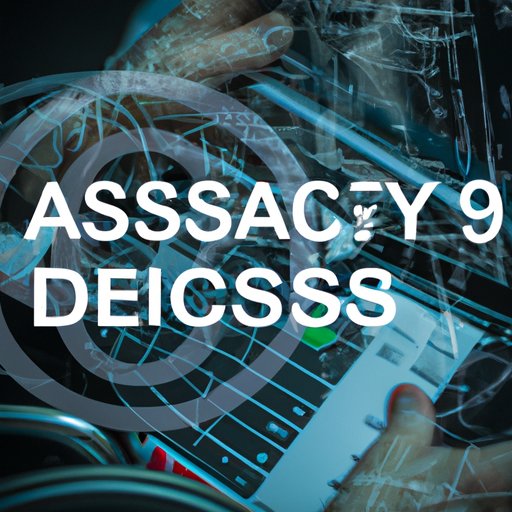Introduction
Technology has become an indispensable part of our lives, and it is important that everyone has access to the same tools and services. Accessible technology is defined as technology that can be used by people with a wide range of abilities and disabilities. Making existing technology more accessible can help ensure that everyone can benefit from the advances in technology, regardless of their level of ability.

Exploring Ways to Make Existing Technology More Accessible
When it comes to making existing technology more accessible, there are several common barriers that must be addressed. These include physical barriers such as the lack of tactile feedback, visual barriers such as small fonts or low contrast, auditory barriers such as loud noises or background music, and cognitive barriers such as complex navigation or jargon-filled instructions. There are also technological barriers such as incompatible operating systems or hardware, or inaccessible websites and applications.
Strategies for making existing technology more accessible include designing products with accessibility in mind, providing alternative ways to access content and information, increasing font sizes and contrast, providing audio descriptions or captions for videos, using clear and simple language, and providing user-friendly tutorials or instructions. Additionally, companies should be aware of the needs of their users and strive to make their products as accessible as possible.
Introducing Assistive Technologies Available for People with Disabilities
Assistive technology is any type of device or system that can be used to enhance the independence and quality of life of people with disabilities. Popular assistive technologies include screen readers, braille displays, text-to-speech software, speech recognition software, eye-tracking systems, and switch control systems. These technologies can help people with disabilities access information and perform tasks that may otherwise be difficult or impossible.
The benefits of utilizing assistive technology include increased independence, improved communication, enhanced safety, better mobility, and increased productivity. Additionally, assistive technologies can help bridge the digital divide between those with and without disabilities, allowing everyone to participate in the digital world.
Examining the Accessibility Features of Popular Tech Products
Many popular tech products have built-in accessibility features that can help make them more accessible. iOS and Android devices have features such as voiceover, magnifier, and color filters, which can help people with visual impairments access the device. Microsoft products such as Windows 10, Office 365, and Edge have features such as Narrator, Magnifier, and Dictation, which can help people with hearing, vision, and motor impairments access the products. Apple products such as Mac OSX, iOS, and Safari have features such as VoiceOver, Zoom, and Switch Control, which can help people with vision, hearing, and motor impairments access the products.

Creating Awareness About the Need for Accessible Technology
In order to make technology more accessible, it is important to create awareness about the need for accessible technology. Education and outreach are key components of this process. Companies should strive to educate their customers about the importance of accessible technology and how it can benefit everyone. They should also work to inform their employees and partners about the need for accessible technology, and how they can help create more accessible products and services.
Tech companies also have a role to play in promoting accessibility. They should strive to make their products and services as accessible as possible and provide resources to help others do the same. Additionally, companies should advocate for policies and legislation that promote accessible technology.

Examining the Current Laws Related to Accessible Technology
There are several laws related to accessible technology that companies should be aware of. The Americans with Disabilities Act (ADA) is a civil rights law that prohibits discrimination against people with disabilities in employment, public accommodations, transportation, and other areas. It requires all public entities and businesses to provide reasonable accommodations for people with disabilities, including making their products and services accessible.
Section 508 of the Rehabilitation Act of 1973 is a federal law that requires all electronic and information technology procured by the federal government to be accessible to people with disabilities. This includes websites, software, hardware, and other products and services. Companies that provide products and services to the federal government must comply with Section 508.
Offering Tips for Software Developers to Make Their Applications More Accessible
Software developers also have a role to play in making technology more accessible. When developing applications, developers should design with accessibility in mind. This includes setting appropriate font sizes, providing alternative ways to access content, and providing clear and simple instructions. Additionally, developers should test and evaluate their applications for accessibility, and provide documentation and support for users to make sure their applications are accessible.
Conclusion
Making technology more accessible is essential for ensuring that everyone can benefit from the advances in technology, regardless of their level of ability. To make existing technology more accessible, companies should design products with accessibility in mind, provide alternative ways to access content and information, increase font sizes and contrast, provide audio descriptions or captions for videos, use clear and simple language, and provide user-friendly tutorials or instructions. Additionally, assistive technologies can help bridge the digital divide between those with and without disabilities, allowing everyone to participate in the digital world. Finally, companies should be aware of the current laws related to accessible technology, and software developers should design and test their applications for accessibility.
(Note: Is this article not meeting your expectations? Do you have knowledge or insights to share? Unlock new opportunities and expand your reach by joining our authors team. Click Registration to join us and share your expertise with our readers.)
